
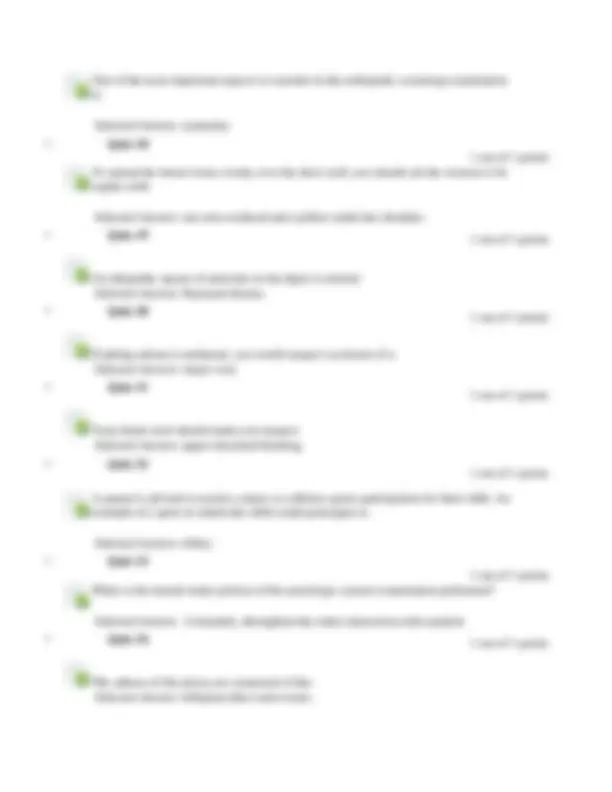
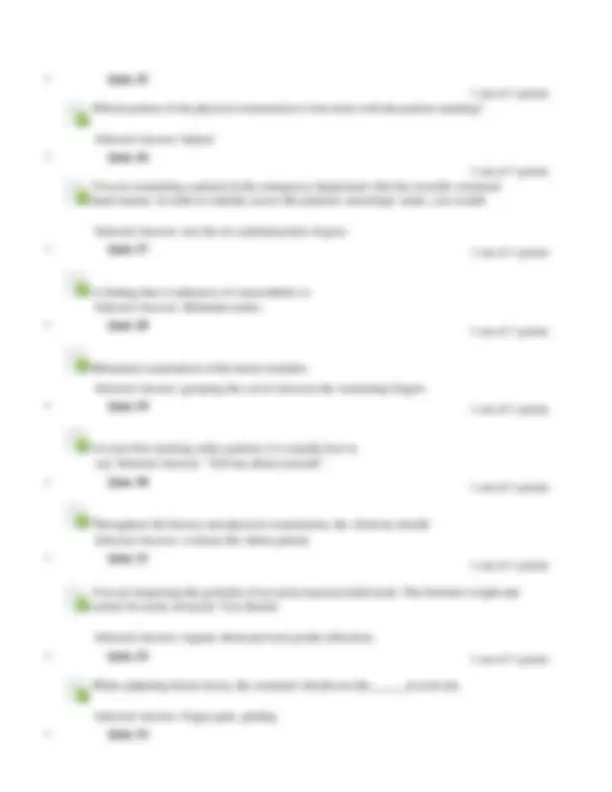
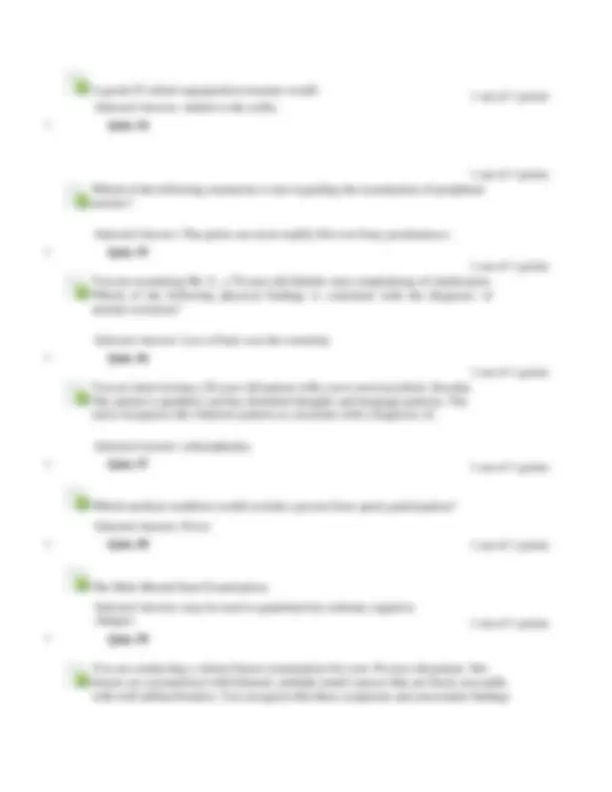
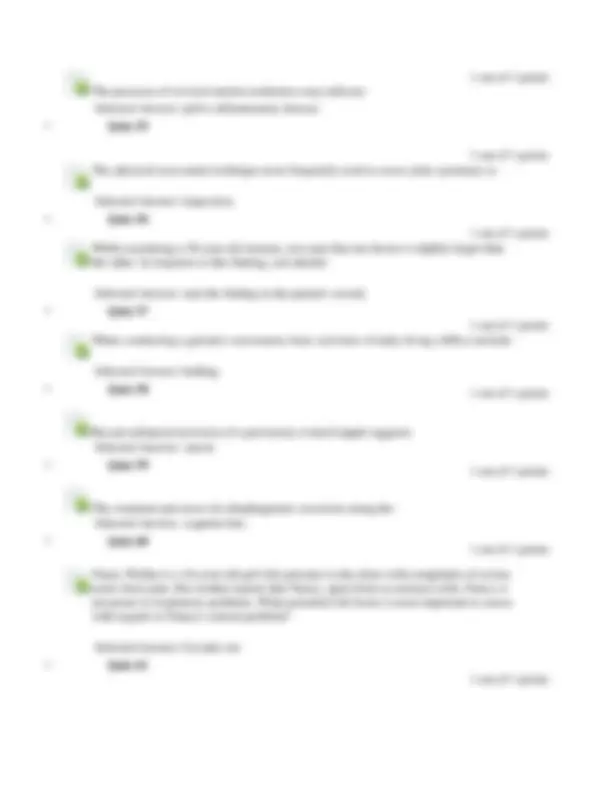
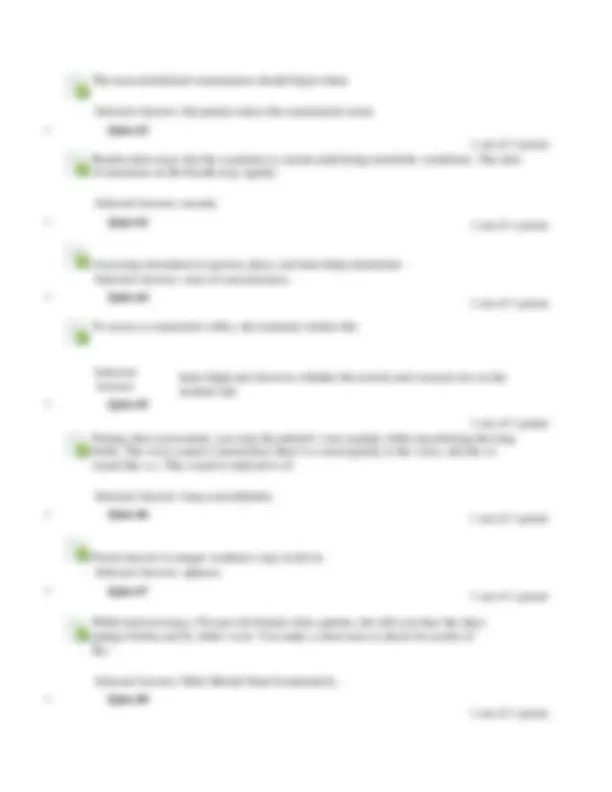
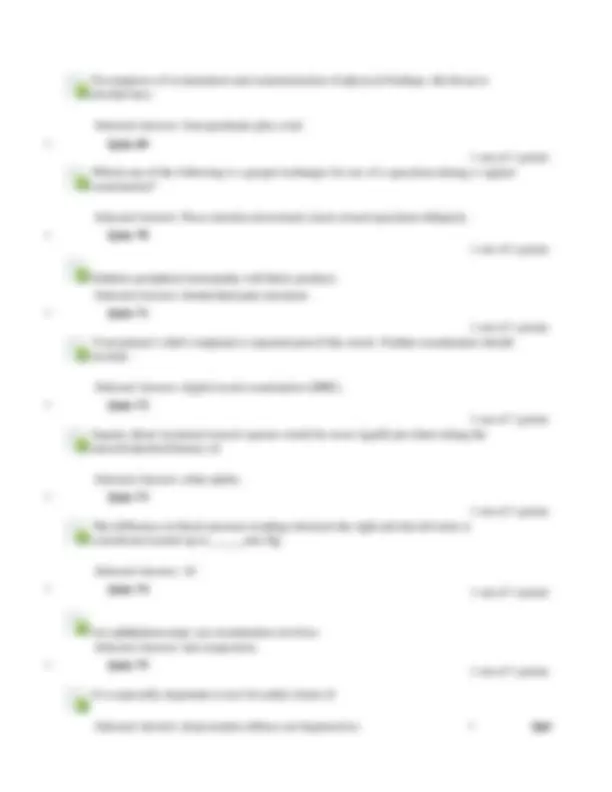
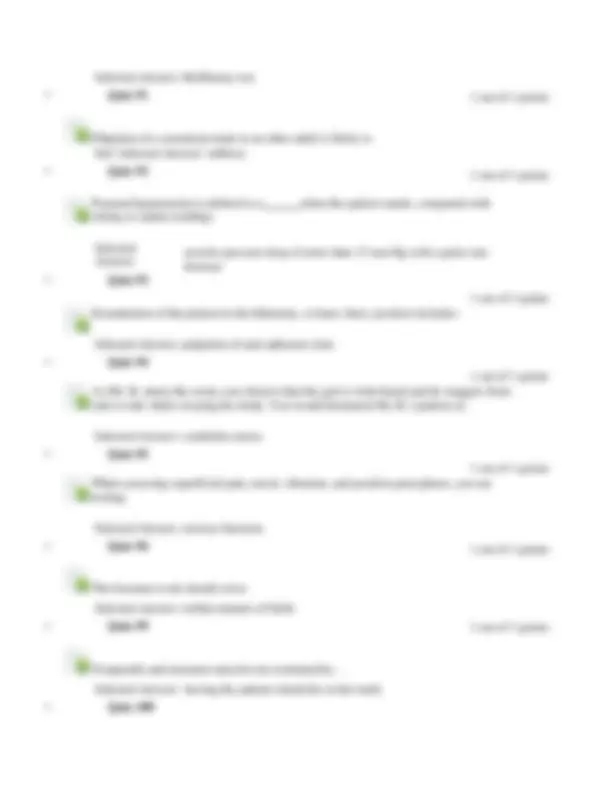



Study with the several resources on Docsity

Earn points by helping other students or get them with a premium plan


Prepare for your exams
Study with the several resources on Docsity

Earn points to download
Earn points by helping other students or get them with a premium plan
Community
Ask the community for help and clear up your study doubts
Discover the best universities in your country according to Docsity users
Free resources
Download our free guides on studying techniques, anxiety management strategies, and thesis advice from Docsity tutors
NURS-6512 LATEST FINAL EXAM 2024/2024/ NURS 6512 QUESTIONS AND 100% CORRECT ANSWERS GRADE
Typology: Exams
1 / 14

This page cannot be seen from the preview
Don't miss anything!









1 out of 1 points The family history for a patient with joint pain should include information about siblings with: Selected Answer: genetic disorders.
- Quiz 4 1 out of 1 points In the adult, the apical impulse should be most visible when the patient is in what position? Selected Answer: Upright - Quiz 5 1 out of 1 points When assessing a 17-year-old for nuchal rigidity, you gently raise his head off the examination table. He involuntarily flexes his hips and knees. To confirm your suspicions associated with this positive test, you would also perform a test for the sign. Selected Answer: Kernig - Quiz 6 A red, hot swollen joint in a 40-year-old man should lead you to suspect: Selected Answer: gout. - Quiz 7 1 out of 1 points 1 out of 1 points Electrical activity recorded by the electrocardiogram (ECG) tracing that denotes the spread of the stimulus through the atria is the: Selected Answer: P wave. - Quiz 8 1 out of 1 points Which cranial nerves are usually evaluated during the examination of the eyes? Selected Answer: III and VI - Quiz 9 1 out of 1 points A pulsation that is diminished to the point of being barely palpable would be graded as: Selected Answ
1 out of 1 points Your 15 - year-old patient is athletic and thin. Radiography of an ankle injury reveals a stress fracture. You should quiz this patient about her: Selected Answer: menstrual cycles.
- Quiz 11 A positive straight leg raise test usually indicates: Selected Answer: lumbar nerve root irritation. - Quiz 12 A common finding in markedly obese and pregnant women is: Selected Answer: lordosis. - Quiz 13 1 out of 1 points 1 out of 1 points 1 out of 1 points A patient you are seeing in the emergency department for chest pain is suspected of having a myocardial infarction. During the health history interview of his family history, he relates that his father had died of "heart trouble." The most important follow-up quiz you should pose is which of the following? Selected Answer: "What age was your father at the time of his death?" - Quiz 14 1 out of 1 points A patient in the deepest coma would be scored a on the Glasgow Coma Scale. Selected Answer: 3 - Quiz 15 Cranial nerve XII may be assessed in an infant by: Selected Answer: observing the infant suck and swallow. - Quiz 16 1 out of 1 points 1 out of 1 points A 23-year-old white woman has come to the clinic because she has missed two menstrual periods. She states that her breasts have enlarged and that her nipples have turned a darker color. Your further response to this finding is to: Selected Answer: suggest pregnancy testing. - Quiz 17 1 out of 1 points
- Quiz 25 1 out of 1 points Which portion of the physical examination is best done with the patient standing? Selected Answer: Spinal - Quiz 26 1 out of 1 points You are examining a patient in the emergency department who has recently sustained head trauma. In order to initially assess this patient's neurologic status, you would: Selected Answer: test the six cardinal points of gaze. - Quiz 27 A finding that is indicative of osteoarthritis is: Selected Answer: Heberden nodes. - Quiz 28 Bimanual examination of the uterus includes: Selected Answer: grasping the cervix between the examining fingers. - Quiz 29 At your first meeting with a patient, it is usually best to say: Selected Answer: "Tell me about yourself." - Quiz 30 Throughout the history and physical examination, the clinician should: Selected Answer: evaluate the whole patient. - Quiz 31 1 out of 1 points 1 out of 1 points 1 out of 1 points 1 out of 1 points 1 out of 1 points You are inspecting the genitalia of an uncircumcised adult male. The foreskin is tight and cannot be easily retracted. You should: Selected Answer: inquire about previous penile infections. - Quiz 32 When palpating breast tissue, the examiner should use the at each site. Selected Answer: finger pads, gliding - Quiz 33 1 out of 1 points
A grade IV mitral regurgitation murmur would: Selected Answer: radiate to the axilla.
- Quiz 34 1 out of 1 points 1 out of 1 points Which of the following statements is true regarding the examination of peripheral arteries? Selected Answer: The pulses are most readily felt over bony prominences. - Quiz 35 1 out of 1 points You are examining Mr. S., a 79 - year-old diabetic man complaining of claudication. Which of the following physical findings is consistent with the diagnosis of arterial occlusion? Selected Answer: Loss of hair over the extremity - Quiz 36 1 out of 1 points You are interviewing a 20 - year-old patient with a new-onset psychotic disorder. The patient is apathetic and has disturbed thoughts and language patterns. The nurse recognizes this behavior pattern as consistent with a diagnosis of: Selected Answer: schizophrenia. - Quiz 37 Which medical condition would exclude a person from sports participation? Selected Answer: Fever - Quiz 38 The Mini-Mental State Examination: Selected Answer: may be used to quantitatively estimate cognitive changes. - Quiz 39 1 out of 1 points 1 out of 1 points 1 out of 1 points You are conducting a clinical breast examination for your 30-year-old patient. Her breasts are symmetrical with bilateral, multiple tender masses that are freely moveable with well-defined borders. You recognize that these symptoms and assessment findings
While collecting personal and social history data from a woman complaining of breast discomfort, you should quiz her regarding: Selected Answer: alcohol, tobacco, and caffeine use.
- Quiz 47 The Denver II is a tool used to determine: Selected Answer: whether a child is developing as expected. - Quiz 48 1 out of 1 points 1 out of 1 points The spread of the impulse through the ventricles (ventricular depolarization) is depicted on the ECG as the: Selected Answer: QRS complex. - Quiz 49 Functional assessment is most important during the examination of a(n): Selected Answer: older adult. - Quiz 50 The best way to ease the apprehension of a 3 - year-old child before a physical examination is to: Selected Answer: let the child hold the stethoscope while you listen. - Quiz 51 An apical PMI palpated beyond the left fifth intercostal space may indicate: Selected Answer: left ventricular hypertrophy. - Quiz 52 Ulnar deviation and boutonniere deformities are characteristic of: Selected Answer: rheumatoid arthritis. - Quiz 53 1 out of 1 points 1 out of 1 points 1 out of 1 points 1 out of 1 points 1 out of 1 points The Mini-Mental State Examination should be administered for the patient who: Selected Answer: gets lost in her neighborhood. - Quiz 33
1 out of 1 points The presence of cervical motion tenderness may indicate: Selected Answer: pelvic inflammatory disease.
- Quiz 55 1 out of 1 points The physical assessment technique most frequently used to assess joint symmetry is: Selected Answer: inspection. - Quiz 56 1 out of 1 points While examining a 30 - year-old woman, you note that one breast is slightly larger than the other. In response to this finding, you should: Selected Answer: note the finding in the patient's record. - Quiz 57 1 out of 1 points When conducting a geriatric assessment, basic activities of daily living (ADLs) include: Selected Answer: bathing. - Quiz 58 Recent unilateral inversion of a previously everted nipple suggests: Selected Answer: cancer. - Quiz 59 The examiner percusses for diaphragmatic excursion along the: Selected Answer: scapular line. - Quiz 60 1 out of 1 points 1 out of 1 points 1 out of 1 points Nancy Walker is a 16 - year-old girl who presents to the clinic with complaints of severe, acute chest pain. Her mother reports that Nancy, apart from occasional colds, Nancy is not prone to respiratory problems. What potential risk factor is most important to assess with regards to Nancy's current problem? Selected Answer: Cocaine use - Quiz 61 1 out of 1 points
For purposes of examination and communication of physical findings, the breast is divided into: Selected Answer: four quadrants plus a tail.
- Quiz 69 1 out of 1 points Which one of the following is a proper technique for use of a speculum during a vaginal examination? Selected Answer: Press introitus downward; insert closed speculum obliquely. - Quiz 70 1 out of 1 points Diabetic peripheral neuropathy will likely produce: Selected Answer: diminished pain sensation. - Quiz 71 1 out of 1 points Your patient's chief complaint is repeated pencil-like stools. Further examination should include: Selected Answer: digital rectal examination (DRE). - Quiz 72 1 out of 1 points Inquiry about nocturnal muscle spasms would be most significant when taking the musculoskeletal history of: Selected Answer: older adults. - Quiz 73 1 out of 1 points The difference in blood pressure readings between the right and the left arms is considered normal up to mm Hg. Selected Answer: 10 - Quiz 74 An ophthalmoscopic eye examination involves: Selected Answer: lens inspection. - Quiz 75 It is especially important to test for ankle clonus if: 1 out of 1 points 1 out of 1 points Selected Answer: deep tendon reflexes are hyperactive. • Qui
z 76 When you attempt to move a 10 - month-old child from his mother's lap to the examination table, he screams loudly. Your best action is to: 1 out of 1 points Selected Answer: perform the examination while the child is in the mother's lap.
- Quiz 77 1 out of 1 points Nerves that arise from the brain rather than the spinal cord are called: Selected Answer: cranial. - Quiz 78 Breath sounds normally heard over the trachea are called: Selected Answer: bronchial. - Quiz 79 If your patient has nipple discharge, you will most likely need a: Selected Answer: glass slide and fixative. - Quiz 80 Which condition is considered progressive rather than reversible? Selected Answer: Dementia - Quiz 81 To hear diastolic heart sounds, you should ask patients to: Selected Answer: lie on their left sides. - Quiz 82 Inspection of the scrotum should reveal: Selected Answer: left scrotal sac lower than the right. - Quiz 83 1 out of 1 points 1 out of 1 points 1 out of 1 points 1 out of 1 points 1 out of 1 points 1 out of 1 points During a routine prenatal visit, Ms. T. was noted as having dependent edema, varicosities of the legs, and hemorrhoids. She expressed concern about these symptoms. You explain
Selected Answer: McMurray test
- Quiz 91 Palpation of a normal prostate in an older adult is likely to feel: Selected Answer: rubbery. - Quiz 92 1 out of 1 points 1 out of 1 points Postural hypotension is defined as a when the patient stands, compared with sitting or supine readings. Selected Answer: - Quiz 93 systolic pressure drop of more than 15 mm Hg with a pulse rate increase 1 out of 1 points Examination of the patient in the lithotomy, or knee-chest, position includes: Selected Answer: palpation of anal sphincter tone. - Quiz 94 1 out of 1 points As Mr. B. enters the room, you observe that his gait is wide based and he staggers from side to side while swaying his trunk. You would document Mr. B.'s pattern as: Selected Answer: cerebellar ataxia. - Quiz 95 1 out of 1 points When assessing superficial pain, touch, vibration, and position perceptions, you are testing: Selected Answer: sensory function. - Quiz 96 The foramen ovale should close: Selected Answer: within minutes of birth. - Quiz 99 Temporalis and masseter muscles are evaluated by: Selected Answer: having the patient clench his or her teeth. - Quiz 100 1 out of 1 points 1 out of 1 points
- Quiz^101 1 out of 1 The strength of the trapezius muscle is evaluated by having the patient: (^) points 1 out of 1 points Part of the screening orthopedic component of the examination includes evaluating the person while he or she is: Selected Answer: duck walking. Selected Answer: push her head against the examiner's hand.